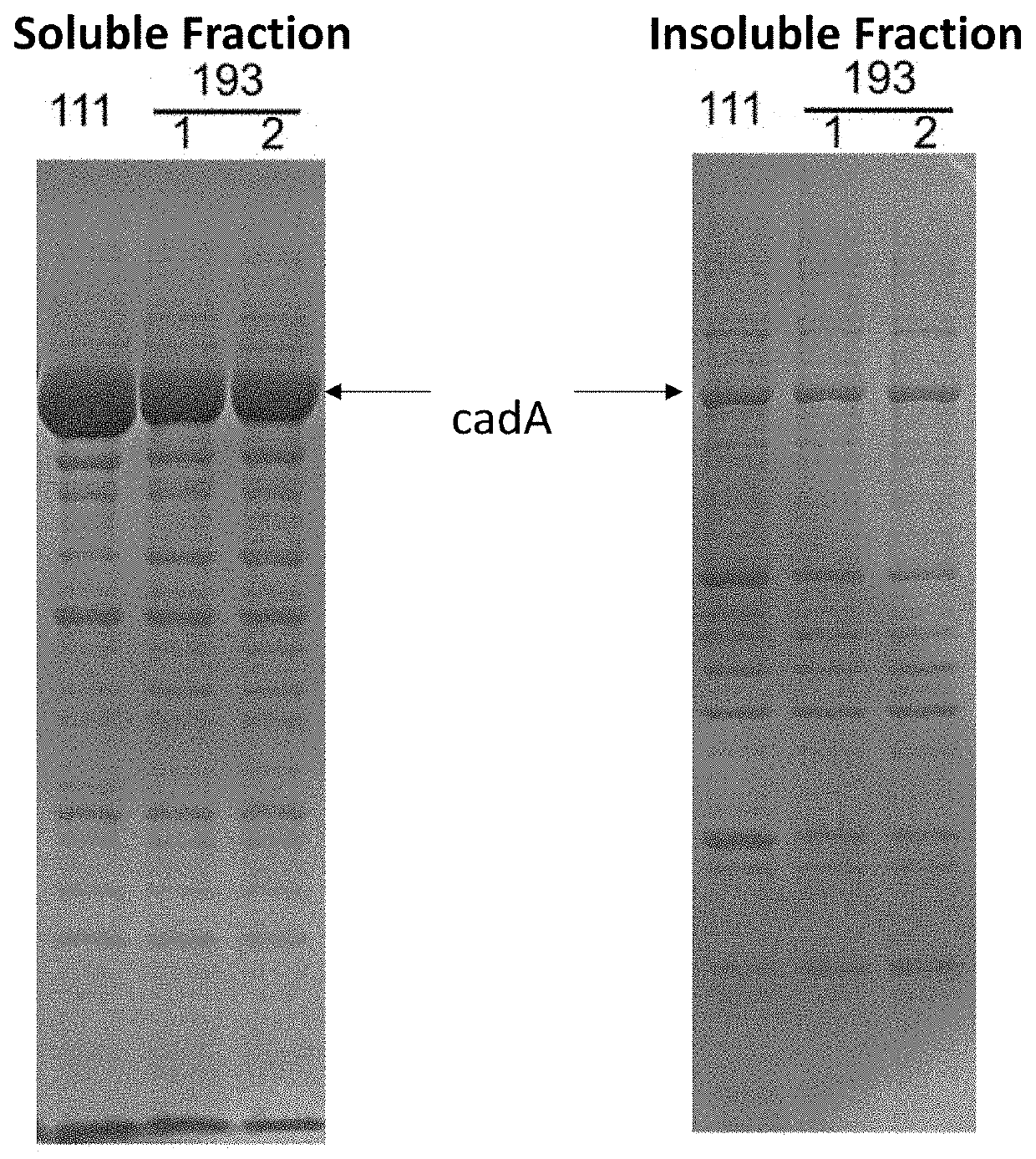Heterologous expression of carbohydrate binding modules and uses thereof for cadaverine production
- Summary
- Abstract
- Description
- Claims
- Application Information
AI Technical Summary
Benefits of technology
Problems solved by technology
Method used
Image
Examples
example 1
Construction of Plasmid Vectors that Encode CadA.
[0089]A plasmid vector containing wild-type E. coli cadA (SEQ ID NO:21), which encodes the lysine decarboxylase CadA (SEQ ID NO:20), was amplified from the E. coli MG1655 K12 genomic DNA using the PCR primers cadA-F and cadA-R, digested using the restriction enzymes Sad and Xbal, and ligated into pUC18 to generate the plasmid pCIB60. The 5′ sequence upstream of the cadA gene was optimized using the PCR primers cadA-F2 and cadA-R2 to create pCIB71. The kanamycin resistance gene npt was amplified using the primers npt-F and npt-R, and cloned behind cadA in pCIB71 to create pCIB111.
example 2
Construction of a Plasmid Vector Expressing a Surface Display Sequence 1pp-ompA.
[0090]A polypeptide that can target a protein fused to its C terminal end to the outer membrane of a Gram-negative bacteria can consist of the leader peptide of the Lpp lipoprotein and a portion of the transmembrane domain of OmpA (Georgiou et al., Protein Eng. 9, 239-247, 1996). The nucleotide sequence encoding the first 29 amino acid residues of E. coli Lpp was amplified using the primers lpp-F1 and lpp-R1, and fused to the nucleotide sequence encoding the amino acid residues 46-159 of E. coli OmpA amplified using the primers lpp-ompA-F and ompA-R. The fusion polypeptide fragment was digested using the restriction enzymes Sad and Xbal, and ligated into pUC18 to generate the plasmid pCIB129. The 5′ sequence upstream of the lpp gene fragment was optimized using the PCR primers lpp-F2 and lpp-R2 to create pCIB143.
example 3
Construction of a Plasmid Vector Expressing the CBD from Cellvibrio Japonicas XynA.
[0091]The amino acid sequence of XynA from C. japonicus was obtained from NCBI (GenBank ID P14768.2) (SEQ ID NO:11). The portion of the protein sequence that includes the XynA CBD was codon optimized (SEQ ID NO:12) for heterologous expression in E. coli. Codon optimization and DNA assembly was performed according to Hoover DM & Lubkowski J, Nucleic Acids Research 30:10, 2002. The synthesized DNA product was amplified with the PCR primers XynA-F and XynA-R, digested using the restriction enzymes Xbal and Sphl, and ligated into pCIB143 to create plasmid pCIB147.
PUM
| Property | Measurement | Unit |
|---|---|---|
| Fraction | aaaaa | aaaaa |
| Fraction | aaaaa | aaaaa |
| Fraction | aaaaa | aaaaa |
Abstract
Description
Claims
Application Information
 Login to View More
Login to View More - R&D
- Intellectual Property
- Life Sciences
- Materials
- Tech Scout
- Unparalleled Data Quality
- Higher Quality Content
- 60% Fewer Hallucinations
Browse by: Latest US Patents, China's latest patents, Technical Efficacy Thesaurus, Application Domain, Technology Topic, Popular Technical Reports.
© 2025 PatSnap. All rights reserved.Legal|Privacy policy|Modern Slavery Act Transparency Statement|Sitemap|About US| Contact US: help@patsnap.com

